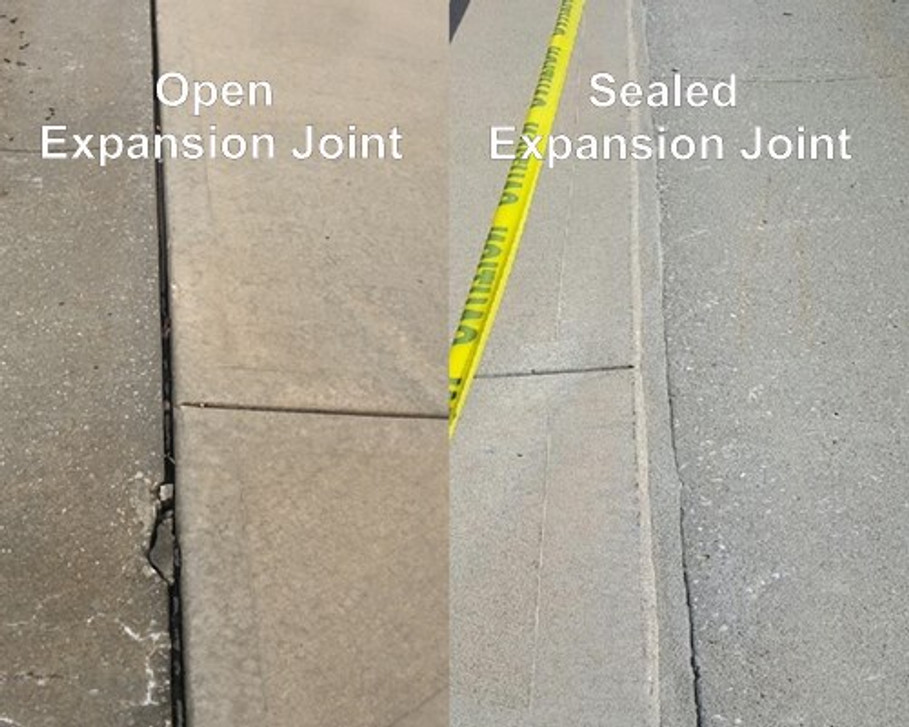There are two types of joints in concrete slabs, expansion joints and crack control joints. Every concrete slab inside (basements, garages, warehouses) or outside (driveways, patios, entries, walkways, pool decks) are required to have joints every eight feet horizontally and vertically. This blog will try to answer the many questions that people have about driveway expansion joints. What are concrete expansion joints for? What is the difference between an expansion joint for concrete and a concrete control joint (also known as a crack control joint or a construction joint)? Why are joints filled or sealed and what materials are used as concrete expansion joint fillers? What is the best way to repair driveway expansion joints and which materials are recommended?
What is an Expansion Joint? - These joints provide space between concrete slabs as a buffer for expansion on hot days and contraction when it is cold. Joints vary in size from half-inch to an inch in width and three to four inches in depth.These expansion joints are installed when the original concrete is poured. A slab without expansion joints will crack where the joint should have been. Cracking destroys the look of the concrete as well as reduces the life of the concrete slab. These joints will crack all the way to the bottom of the concrete.
What are Crack Control Joints? - These joints allow cracking in a controlled area as the slab settles over time. These are also known as break joints, construction joints or saw-cut joints. Usually these are cut into the slab after the concrete hardens. Crack control joints vary in size from one-eighth inch to one-quarter inch in width and half inch in depth. A slab without these joints will crack in random patterns which ruins the look of the concrete as well as allows for damage from water intrusion and freeze-thaw which will reduce the life of the slab.
Why are joints filled or sealed and what materials are used? When expansion joints are not closed or sealed, they become an area where dirt and debris can collect and then become a spot where weeds or other vegetation can grow. This growth further erodes the joint filler material. When joints become open, water is allowed to run under the bed of the slab, eroding it and creating voids which during freezing winter conditions can heave and cause major cracks and displacement in the concrete. With nothing to support the slab, cracks and uneven concrete surfaces can be created.
Open joints can also be point of deterioration in the concrete because of the freeze-thaw effect (constant expansion and contraction). This deterioration can cause the concrete to chip and create trip points.
These joints are typically filled with wood or a soft material called felt so they can move with the expansion and contraction of the concrete. These types of joint materials do not survive well; frequently getting caught on equipment and pulled out of the joint or becoming loose and then the homeowner removes all or a portion of the joint material.
What is the best way to repair a driveway expansion joint and what materials are recommended? - It is very important to keep joints in good repair. An annual inspection of joints should be on every homeowner's to-do list. Knowing the proper way to repair these joints is equally important.
The most common repair method is to fill them up with a concrete patch repair material. This is not an optimal solution as the concrete will not expand and contract but will crack. We recommend the professional method using Vulkem 45 SSL Caulk, Vulkem 116 Caulk , Backer Rod, and Finishing Sand to repair the joints. (See also the Do It Yourself Driveway Joint Repair Bundle) This method prevents water penetration and dirt and foreign matter accumulation while allowing the slab to move as it expands and contracts. The caulk has an expected life of 7 to 10 years as it will allow for movement. It is a repair method that homeowners can do themselves and that contractors will appreciate because they will have less call-backs. When the joint that has been sealed with caulk is finished with fine sand, it blends in with the driveway and becomes less obvious. Repairing joints using this method improves the look of your property and will prevent problems in the future. This meets all ASTM requirements for commercial joint repair.
Expansion Joint Repair Results:
- Prevents water from running below concrete creating voids
- Prevents weed and grass growth Eliminates the accumulation of dirt, salt, and other foreign materials
- Prevents breakage and creating trip points
- Bonds to concrete for long service life and allows for movement
- Prevents water from getting to re-bar and creating rust
- Easier to clean
- Improves appearance of property
- Easier to remove ice and snow
- Reduces damage from freeze/thaw expansion and contraction

